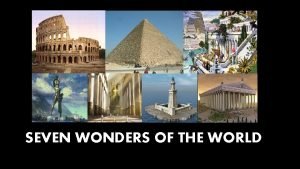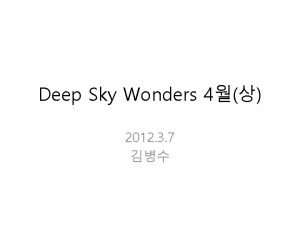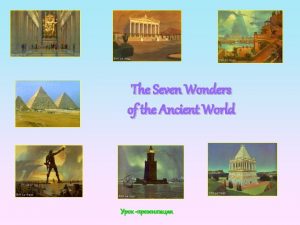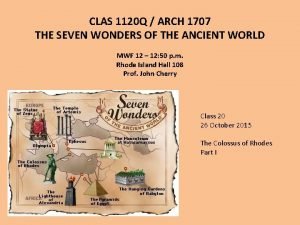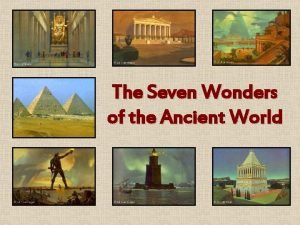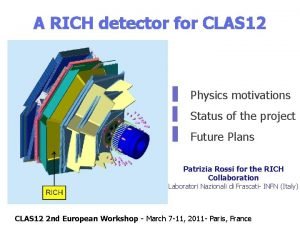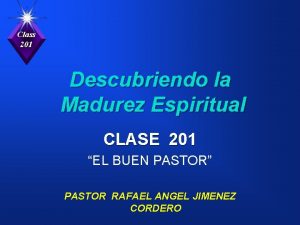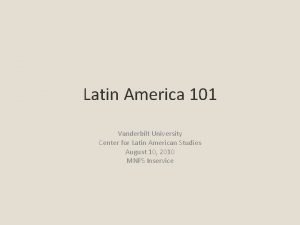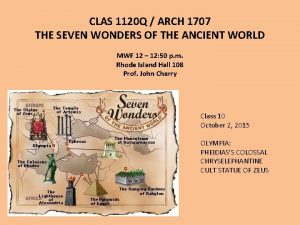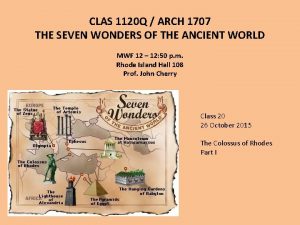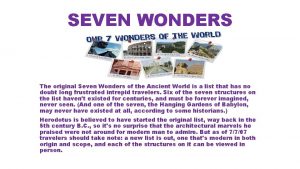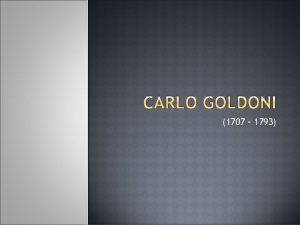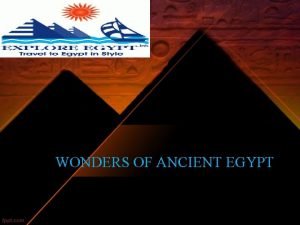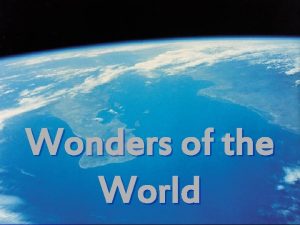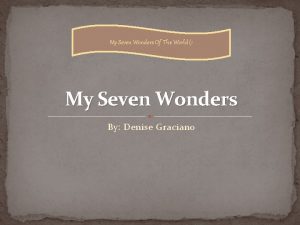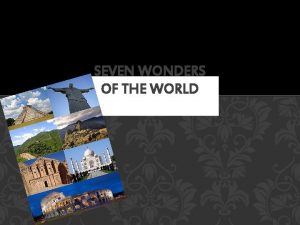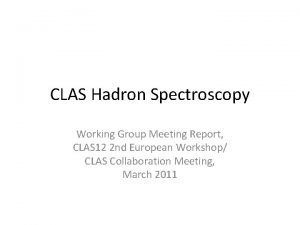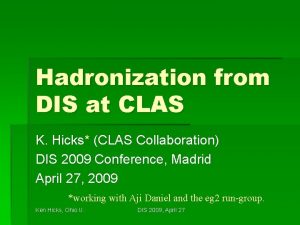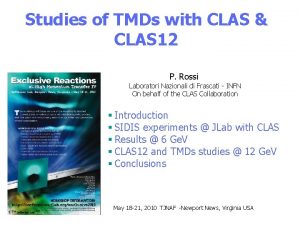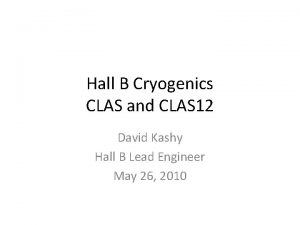CLAS 1120 Q ARCH 1707 THE SEVEN WONDERS
























- Slides: 24

CLAS 1120 Q / ARCH 1707 THE SEVEN WONDERS OF THE ANCIENT WORLD MWF 12 – 12: 50 p. m. Rhode Island Hall 108 Prof. John Cherry Class 20 26 October 2015 The Colossus of Rhodes Part I

Trivia Question: Does the name Rhode Island have anything to do with the Greek island of Rhodes? Maybe: The explorer Giovanni da Verrazzano in 1524 noted an island near the mouth of Naragansett Bay, which he likened to the (Ottoman) Greek island of Rhodes. Which island is not clear. The Pilgrims who later colonized the area assumed that Verrazzano’s Rhodes was Aquidneck Island. Or maybe not… Dutch explorer Adriaen Block passed by Aquidneck Island in the 1610 s, and later (1625) described it in 17 th-century Dutch as Een rodlich Eylande (an island of reddish appearance). Earliest documented used of Rode Island for Aquidneck was by Roger Williams in 1637

Ephesus Halicarnassos Rhodes

Ancient writers on the Colossus of Rhodes Philo of Byzantium, Pliny the Elder, Strabo (extracts in Clayton & Price textbook) Pliny the Elder, Natural History 34. 41 Calling for admiration before all others was the colossal statue of the Sun at Rhodes, made by Chares of Lindos, pupil of Lysippus mentioned above. This statue was 70 cubits (i. e. , ca. 110 feet) high; and 56 years after its erection, was overthrown by an earthquake, but even lying on the ground it is a marvel. Few people can make their arms meet around the thumb of the figure, and the fingers are larger than most statues; and where the limbs have broken off enormous cavities yawn, while inside are seen great masses of rock with the weight of which the artist steadied it when he erected it. It is recorded that it took 12 years to complete and cost 300 talents [ca. $3 -4 million], money realized from the engines of war belonging to King Demetrius which he had abandoned when he got tired of the protracted siege of Rhodes This tells us about the artist, subject, size, duration, and cost… …but very little about appearance or construction methods

The historical context of the Colossus • Rhodes founded in 408 BC as a federal capital from the synoecism of Ialysos, Lindos, and Kamiros • On Alexander the Great’s death in 323 BC, his empire divided between: Ptolemy (Egypt), Seleucus (the Near East), Antigonus (western Asia, the Aegean) • Antigonus becomes king of Macedonia, founder of Antigonid dynasty, strongest man in Asia Minor; harasses Ptolemy I of Egypt in the eastern Mediterranean • 307 BC: Antigonus asks the Rhodians to ally with him in a war against Ptolemy I; Rhodians refuse (because of prosperous trading relationship with Egypt) • Led to the siege of Rhodes, 305 -4 BC, by Demetrius Poliorcetes (‘the besieger’), Antigonus’s son • Huge army of 40, 000 soldiers, 30, 000 workmen, 200 warships, 170 transport ships • Use of gigantic siege engines, one called the Helepolis (‘City-taker’) • Siege lifted 304 BC, leaving behind the siege equipment, which the Rhodians sold, to provide funds for the erection of an enormous bronze statue by Chares • Constructed ca. 294 -282 BC

What did the Colossus look like? —Nothing survives —Collapsed in earthquake of 226 BC —Scrap carted away by 7 th century AD The Colossus of Rhodes Woodcut by Jean Cousin published in André Thevet’s Cosmographie de Levant (Lyon 1556) • This is the first image of a giant statue bestriding the harbor entrance (for which there is no ancient testimony) Why, man, he doth bestride the narrow world Like a Colossus; and we petty men Walk under his huge legs, and peep about… William Shakespeare, Julius Caesar (Act I, Scene 2) 1599

The town of Rhodes and its twin harbors

George Balthazar Probst, 18 th century An Amusement for Young Gentlemen and Ladies (late 1790 s) Johann Bernhard Fischer von Erlach, “The Colossus of Rhodes”, from Entwurf einer historischen Architektur (1721)

Almost all reconstructions of the Colossus have imagined it as bestriding the harbor entrance (i. e. Cousin’s vision of it)

Lord North (1732 -1792) satirized as the Colossus of Rhodes on the eve of the American Revolution. (Original in the John Nicholas Brown Library, Brown University) North was British Prime Minister 1770 -1782, and led Great Britain throughout much of the War of American Independence.

“The Rhodes Colossus” Caricature of Cecil John Rhodes (1853 -1902) British colonial imperialist in Africa Founder of the De Beers diamond company Founder of the state of Rhodesia (Zimbabwe) Founder of the Rhodes Scholarships Punch, December 10, 1892

Salvador Dali The Colossus of Rhodes 1954

Salvador Dali’s imagining of the Statue of Zeus at Olympia and the Pharos of Alexandria

Statue of Liberty, New York Harbor Auguste Bartholdi, dedicated 1886 In commemoration of the French and American revolutions 152 feet high Imagined as a “New Colossus” (note radiate crown and torch; cf. Rhodian colossus), and as Emma Lazarus’s dedicatory sonnet makes clear: Not like the brazen giant of Greek fame, With conquering limbs astride from land to land… Give me your tired, your poor, Your huddled masses yearning to breathe free, The wretched refuse of your teeming shore…

The race to build the world’s tallest sculpture Spring Temple Buddha (2002, Lushan, China) 420 feet high Mother Russia (1967, Volgograd, Russia) 279 feet high

The Angel of the North, Anthony Gormley

Anish Kapoor, The Acelormittal-Orbit, UK Olympic Park, London

The Colossus of London “The Spirit of Man” • a gas-fired beacon figure • 320 -foot tall, including the base ( Statue of Liberty = 151 feet; Colossus of Rhodes = 120 feet; Big Ben = 320 feet) • next to the River Thames, facing the rising sun • internal frame of steel girders, outer skin of interwoven copper tubing • natural gas pumped through outer tubing and ignited, signifying “the incandescent spirit of man” • face will be gold, hands bronze, feet of granite or limestone blocks • the internal structure will contain several floors, with viewing lobbies, a lounge, museum, gift shop, cafes, etc. 2008 Greek announcement: Colossus of Rhodes to be rebuilt as a giant light sculpture East German artist: Gert Hof Anticipated height: between 60 and 100 m (ca. 200 – 330 feet) Anticipated cost: ca. 200 million euros

The Colossus was the work of the sculptor Chares… … a pupil of Lysippus, who was: • Born ca. 390 BC • According to Pliny, created over 1, 500 works, all in bronze • Some were colossal in scale • Chosen by Alexander the Great to be the sole sculptor to create his image

Alexander the Great defines and controls his own distinctive image

Alexander the Great as the sun-god Helios Alexander – Helios, Rhodes Museum 3 rd century BC, double life size Holes drilled around the head indicate that it wore a gilded sunburst, as in statues of Helios Alexander the Great Capitoline Museum, Rome (Roman copy after a 4 th century original by Lysippus) Alexander – Helios, British Museum 2 nd-1 st century BC

Helios • Personification of the sun in Greek mythology • Brother of Selene (moon) and Eos (dawn) • Imagined as a god crowned with the aureole of the sun, who drove his 4 -horse chariot across the sky each day, to Oceanus that circled the earth, returning through the ocean to the East by night • Romanized as Sol: under Julian the Apostate, Sol Invictus was recognized as the sole and supreme god • Helios was the city-god of Rhodes

Rhodian tetradrachm coins, with image of Helios Coin of the Emperor Constantine, With reverse image of Sol Invictus (invincible sun) Note radiate crown

Perhaps a best guess at the general appearance of the Colossus of Rhodes? • Radiate crown • Perhaps a face resembling Alexander’s? • Standing on a podium • Not bestriding the harbor of Rhodes
 Diana inkpen
Diana inkpen Seven wonders of the world
Seven wonders of the world Seven wonders of the world 2012
Seven wonders of the world 2012 New seven wonders foundation
New seven wonders foundation Map of seven wonders of the ancient world
Map of seven wonders of the ancient world Salvador dali seven wonders
Salvador dali seven wonders Taj mahal seven wonders
Taj mahal seven wonders World map with 7 wonders
World map with 7 wonders Wonders of the world
Wonders of the world Grand canyon seven wonders of the world
Grand canyon seven wonders of the world Seven heavenly virtues
Seven heavenly virtues Mhrsb
Mhrsb Clas
Clas Clas nord
Clas nord Uf clas advising appointment
Uf clas advising appointment Clas collaboration meeting
Clas collaboration meeting Clas collaboration meeting
Clas collaboration meeting Clase 201 descubriendo mi madurez espiritual pdf
Clase 201 descubriendo mi madurez espiritual pdf Lish 3
Lish 3 Clas
Clas Clas
Clas Si plusat si vargat apa-ndata a zvantat
Si plusat si vargat apa-ndata a zvantat Clas
Clas Classdoje
Classdoje Clas vanderbilt
Clas vanderbilt

